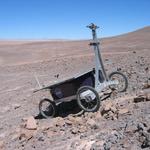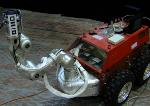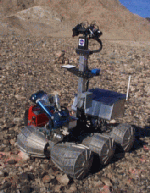

|
Trey Smith
Roboticist, NASA Ames Research Center
|
Research scientist and systems engineer with over fifteen years of experience designing human-robot systems for space exploration.
My passion is building tools to help experts do their job better. In many of the applications I've worked on—ranging from disaster management, to planetary probes on land and sea, to a new free flying robotic research platform in the ISS—a common thread is expert human teams working together to manage a complex system generating overwhelming amounts of data. We must design the system itself to be safe, robust, and adaptable, and the information systems and human organization around it to maintain situation awareness and make effective real-time decisions.
Particularly interesting for me are highly flexible platforms that can become leaping-off points for the creativity of future researchers, and artificial intelligence techniques for science autonomy—robotic systems that can interpret their own data and respond intelligently to maximize scientific productivity.
The most rewarding part of my work has been the great friendships and learning opportunities that come from supporting researchers across a broad variety of scientific disciplines.
I was a Ph.D. student at the Field Robotics Center of the The Robotics Institute at Carnegie Mellon University, in Pittsburgh, PA.
My Ph.D. technical contributions focused on POMDPs -- partially observable Markov decision processes. You can use POMDPs to model planning problems with uncertain action outcomes, hidden state, and noisy sensing. POMDP planners are particularly good at deciding when to use information gathering actions. My work is in heuristic search algorithms that quickly generate near-optimal policies both for POMDPs and for simpler MDP problems.
(Older) Past Projects
| |

|
Limits of Life in the AtacamaThis project developed techniques for robotic astrobiology by studying life in extreme environments on Earth. Parts of the Atacama Desert in Chile have never received rainfall in recorded history; they are theorized to be absolute deserts, entirely devoid of life. Field investigation over three years used the Zoe rover to characterize the distribution of life. My role was to help provide the rover with science autonomy capabilities--it used onboard image analysis to detect the presence of chlorophyll and automatically took more detailed followup measurements.
|

|
FIRE Architecture ProjectThe FIRE Project looked at multi-robot architectures similar to those we studied for DIRA (see below), but mostly in simulation and in the context of Mars exploration with multiple rovers. The project was an early use of market-based techniques for multi-robot task allocation. |

|
Distributed Robot Architectures (DIRA) ProjectDIRA looked at architectures for coordinating multiple heterogeneous robots. We demonstrated the system with three robots: (1) the RoboCrane, a crane with 6 DOF control of its end effector, (2) Bullwinkle, a mobile robot with a 5 DOF arm mounted on the front, and (3) Xavier, another mobile robot with stereo cameras. Together they performed a beam docking task. The RoboCrane provided heavy lifting and gross control, Bullwinkle provided fine control for the docking, and Xavier provided relative position updates that were used to guide both manipulators. I helped to develop a software framework for implementing the multi-robot control architecture, and did a lot of integration.
|

|
Mars Autonomy ProjectWe developed software for sending a rover tens of meters through rocky terrain like that seen by NASA's Viking and Pathfinder landers. The hard parts were interpreting the rover's stereo data into useful obstacle maps, and then integrating our local obstacle avoidance module (Morphin) with our global path planner (D*). Both Morphin and D* were inherited from earlier projects.I spent summer 2000 at JPL working with Mark Maimone to port our software for the Rocky VII rover, and test it in the Mars Yard. Update: Mark later developed a Morphin extension called GESTALT that was used very successfully for navigation on the MER rovers.
|

|
Advanced Autonomy for Rovers Project at NASA AmesThe project as a whole was implementing software for streamlined ground operations and better onboard intelligence for future Mars rovers. I worked with the onboard reactive execution system in development for field trials of the Marsokhod rover. I designed a language to express contingent plans from the planner. Elements of this language are incorporated into the Contingent Rover Language that is still in use (as of this writing, 2004).
|
|
|
RETSINA ProjectRETSINA is an architecture for multi-agent systems that focuses on information retrieval and integration. During a summer internship as an undergrad, I helped with some of the infrastructure, in particular the language and the parser that agents use to communicate.
|